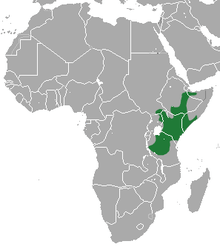Rufous elephant shrew
| Rufous elephant shrew[1] | |
|---|---|
 | |
| Scientific classification | |
| Kingdom: | Animalia |
| Phylum: | Chordata |
| Class: | Mammalia |
| Order: | Macroscelidea |
| Family: | Macroscelididae |
| Genus: | Elephantulus |
| Species: | E. rufescens |
| Binomial name | |
| Elephantulus rufescens (Peters, 1878) | |
 | |
| Rufous elephant shrew range | |
The rufous elephant shrew, rufous sengi or East African long-eared elephant-shrew (Elephantulus rufescens) is a species of elephant shrew in the family Macroscelididae. Found in Ethiopia, Kenya, Somalia, South Sudan, Tanzania and Uganda,[2] its natural habitats are dry savanna and subtropical or tropical dry shrubland.[2]
Distribution
Elephantulus rufescens occupies the drywood land and grassland zone of East Africa.[3]
Characteristics
E. rufescens exhibits no sexual dimorphism. The probosis is long and flexible. The species' tails are dark-brown and can be long up to the its head-to-tail length. Females have three pair of teats and the males have internal testes. Both adults and juveniles are similar in color. However, adults have white feet while juveniles' feet are brown. [4]
Ecology, diet, and behavior
Rufous elephant shrews are active throughout the day, with peaks in activity at dusk and dawn while having a midday rest. The males usually spend most of their time cleaning the foraging trails. Except for foraging, all activities are performed in these trails. Trails act as an important means for escaping from predators. Insects form the major food resource of their diet in the dry season, while seeds are consumed during periods of rain.[3]
This species is fairly monogamous; however, members of a monogamous pair spend little time together and are limited in social interaction. They live in a matriarchal society in which the female of the pair usually dominates the male. [5]
References
- ↑ Bronner, G.N.; Jenkins, P.D. (2005). "Order Afrosoricida". In Wilson, D.E.; Reeder, D.M. Mammal Species of the World: A Taxonomic and Geographic Reference (3rd ed.). Johns Hopkins University Press. p. 83. ISBN 978-0-8018-8221-0. OCLC 62265494.
- 1 2 3 Rathbun, G.B. (2015). "Elephantulus rufescens". IUCN Red List of Threatened Species. IUCN. 2015: e.T42664A21289073. doi:10.2305/IUCN.UK.2015-2.RLTS.T42664A21289073.en. Retrieved 27 August 2016.
- 1 2 Neal, B. R. "Relationship between feeding habits, climate and reproduction of small mammals in Meru National Park, Kenya". African Journal of Ecology. doi:10.1111/j.1365-2028.1984.tb00695.x. Retrieved December 24, 2015.
- ↑ Fred W. Koontz & Nancy J. Koeper. "Elephantulus rufescens". The American Society of Mammalogists. Retrieved April 15, 2014.
- ↑ Lumpkin, Susan & Fred W. Koontz. "Social and Sexual Behavior of the Rufous Elephant-Shrew (Elephantulus rufescens) in Captivity.". JSTOR 1381007.
External links
- BBC Wildlife Finder - with video clip (UK-only) from Life
- Elephantulus rufescens at the IUCN Red List of Threatened Species
